This creamy, cheesy winter squash gratin can be made with kabocha, delicata, acorn or almost any winter squash. It's simple to make using just a few ingredients.
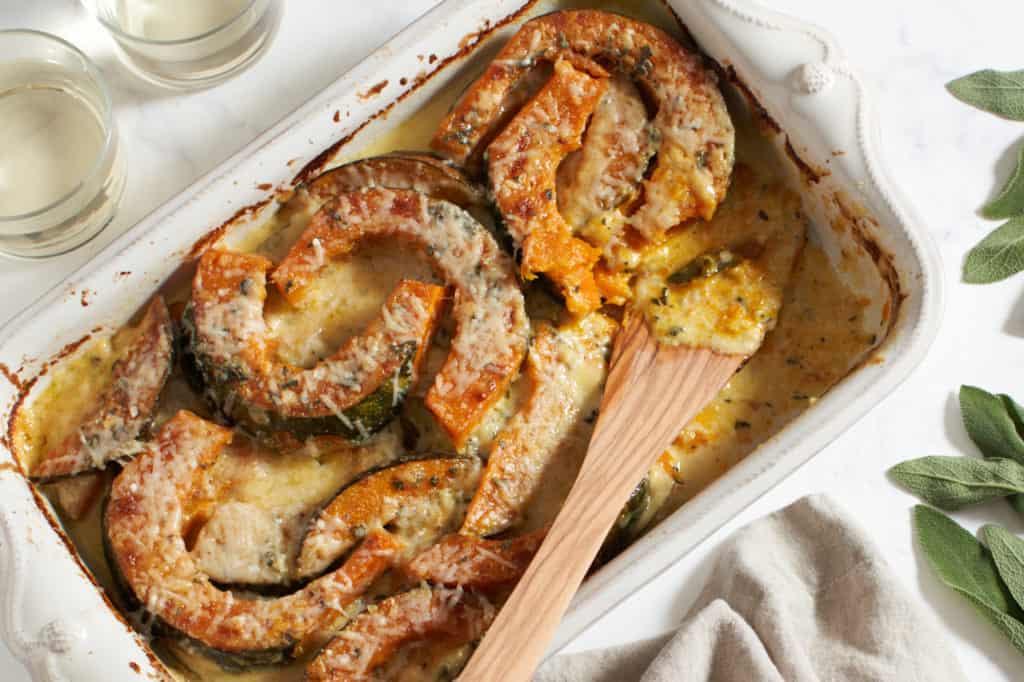
As winter squash gratins go, this one is not too heavy. We'll use parmesan cheese instead of the traditional Gruyère, and the ratio of squash to sauce is a good balance, the sauce doesn't overpower the dish.
The magic of shallots and sage come together to make this a wildly delicious and comforting side dish recipe that you'll want to serve all through the fall and winter.
I do love a good gratin. Try my Sweet Potato Gratin for more of these traditional fall flavors, or my Chipotle Sweet Potato Gratin for a fun twist on a classic.
Jump to:
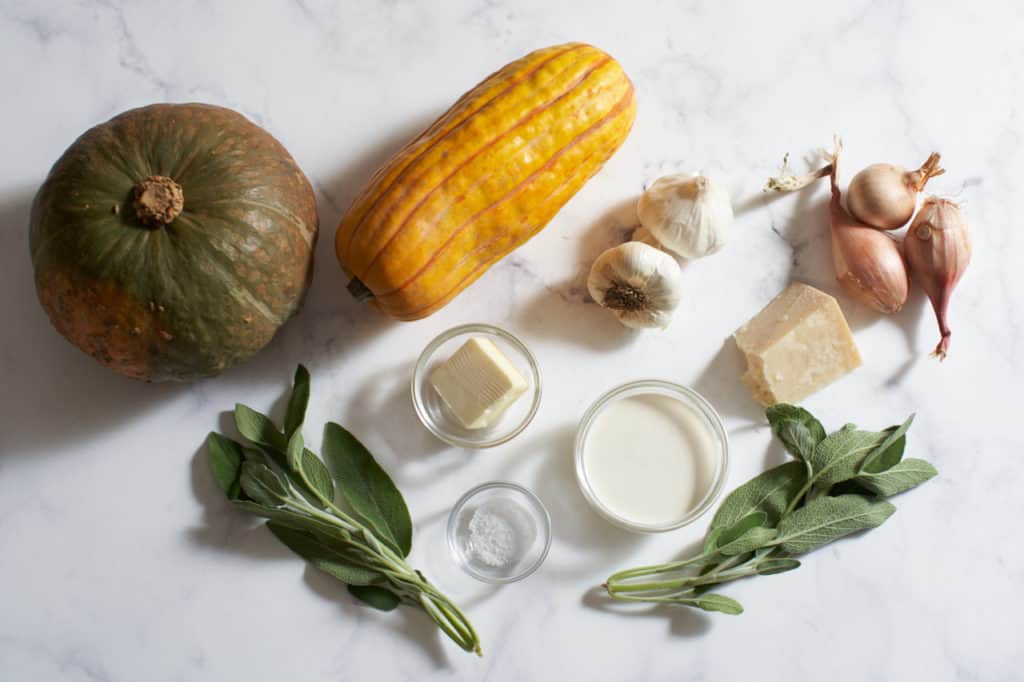
Ingredients in winter squash gratin
- Winter squash: I used kabocha squash in these photos, but you could also use other winter squash varieties such as acorn or delicata, that's the combination that I use to make my winter squash agrodolce.
- Parmesan cheese: The only cheese we'll use, so it doesn't get too heavy. Be sure to use real parmigiano reggiano for the best flavor.
- Heavy cream: This is the base of our sauce that will be infused with the aromatics below.
- Shallots and garlic: Shallots are the key to the synergy of flavors in this dish. Their unique, mild sweetness just brings every other ingredient to life and melds everything together.
- Fresh sage: I can never get enough sage in fall and winter recipes! So good and the perfect complement to the flavor of winter squashes.
- Butter and kosher salt: We'll soften the shallots and garlic in butter for the base of the sauce and season it with just a pinch of salt. The parmesan has plenty of salt so be sure not to be too heavy handed.
*Ingredients with measurements are listed in the recipe card below.
Curious about kabocha?
If you've never tried kabocha squash, this is the gratin recipe that will entice you to finally do it! It has a rich, nutty, earthy flavor, and pairs amazingly well with this creamy, cheesy gratin sauce. It's a Japanese variety that's often used in tempura, and the skin is thin and edible. No peeling! Yay!
How to make winter squash gratin
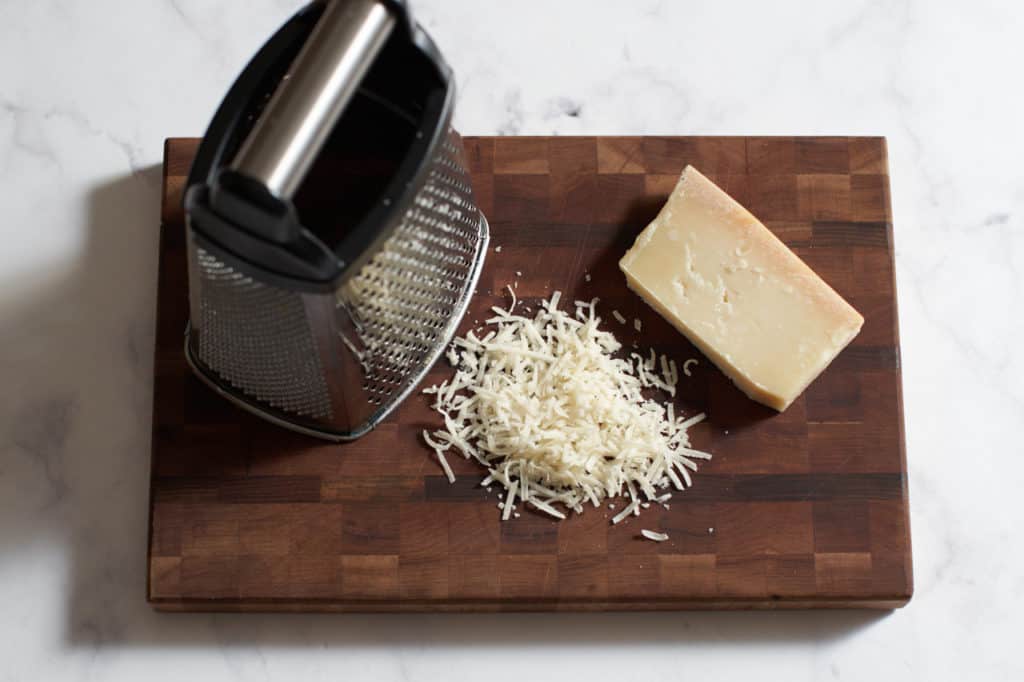
Step 1: Grate the parmesan cheese
Preheat the oven to 400°F. Grease a 9x13 baking dish with butter. Use the small side of a box grater to grate the parmesan and set aside. See tip below.
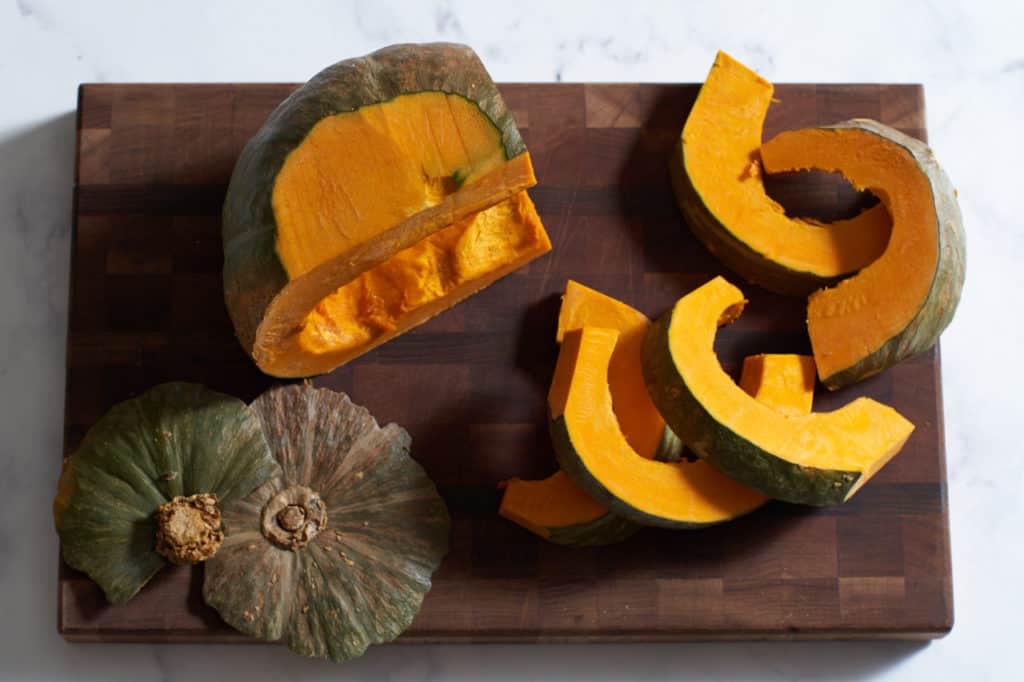
Step 2: Cut the squash
Carefully slice the squash open and scoop out the seeds. (Save them for roasting if desired.) Carefully remove the bottom end and stem end of the squash.
Want to save this recipe?
You'll join hundreds of readers on my email list!
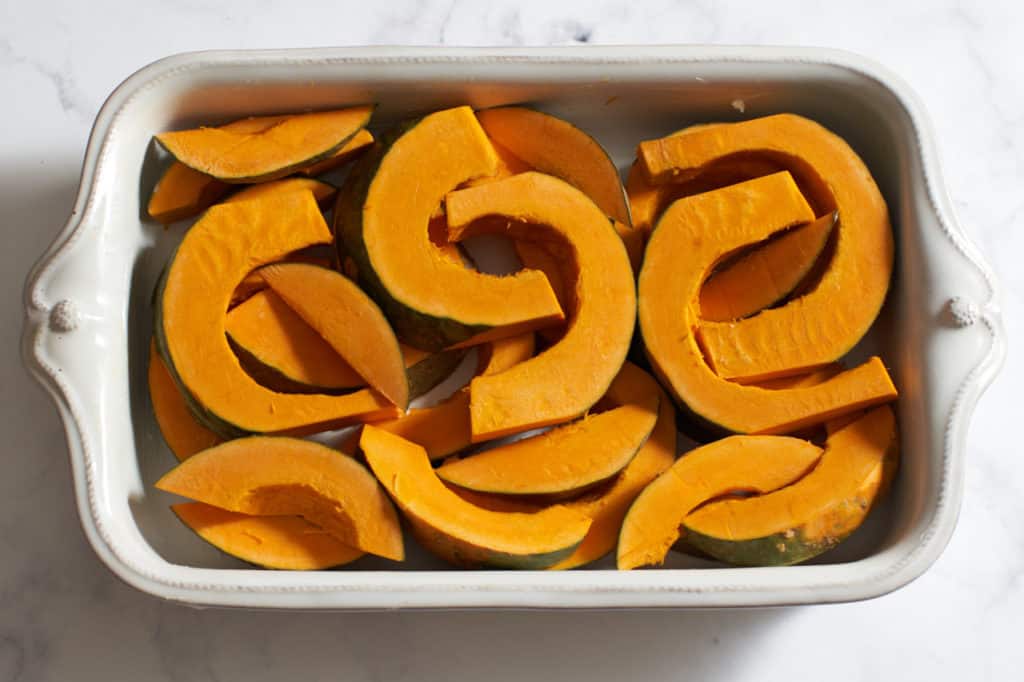
Slice the squash into ½ inch thick slices and arrange them in two or three layers in the baking dish. If you'd rather use thinly sliced squash that is fine, too. I just think the thicker slices are easier—less work!—and I like the texture.
No need to peel!
If using kabocha, acorn, or delicata squash, you can leave the peel intact. It's thin and edible, and adds a little texture. (But do peel butternut. The skin is edible, but it's thicker, so not as pleasant in this recipe.)
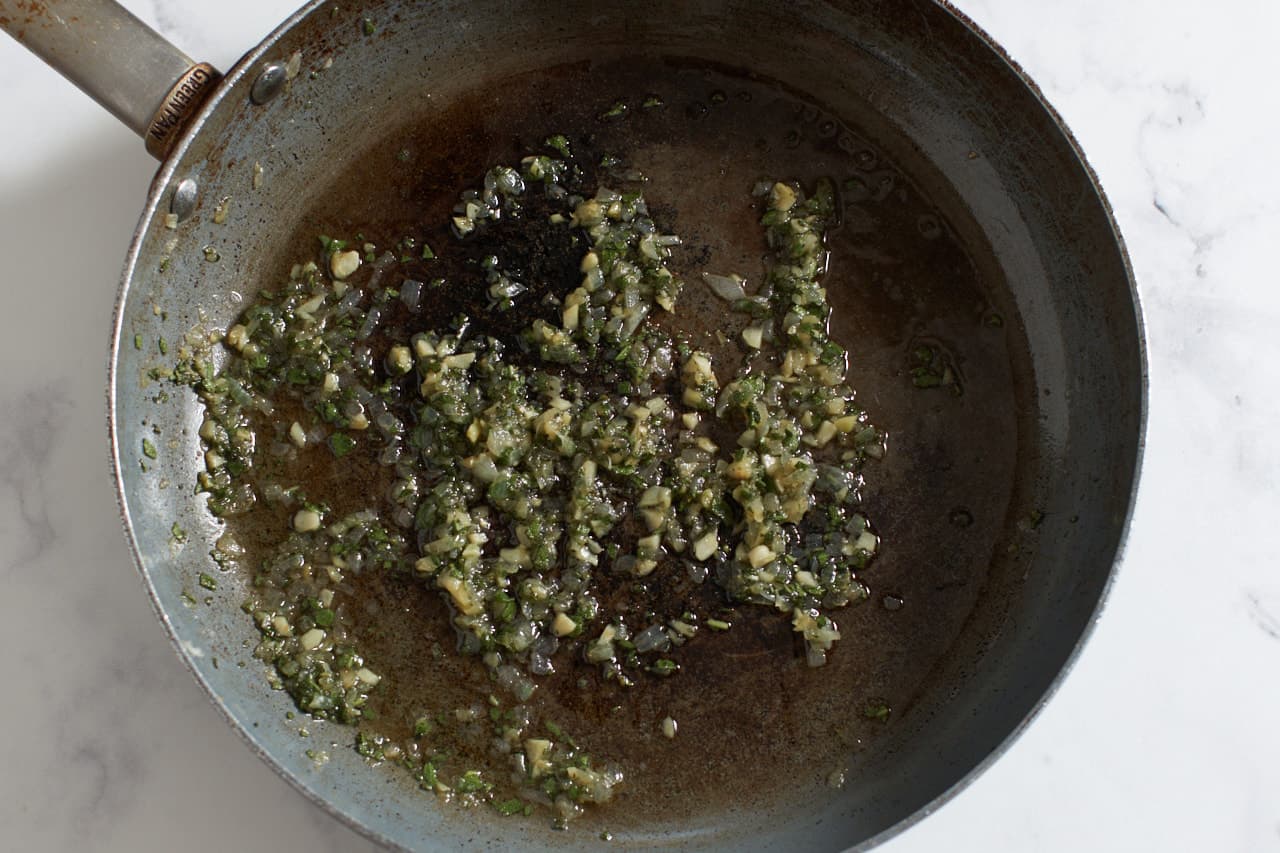
Step 3: Chop and sweat the sage and aromatics
Use a good chef's knife, finely chop the sage, finely dice the garlic and shallots. In a large skillet over medium heat, melt the butter, then add the shallots and garlic and a pinch of salt to sweat them.
Cook for about 5 minutes, until they are soft and translucent. Then add the sage and stir until fragrant, about 1 minute.
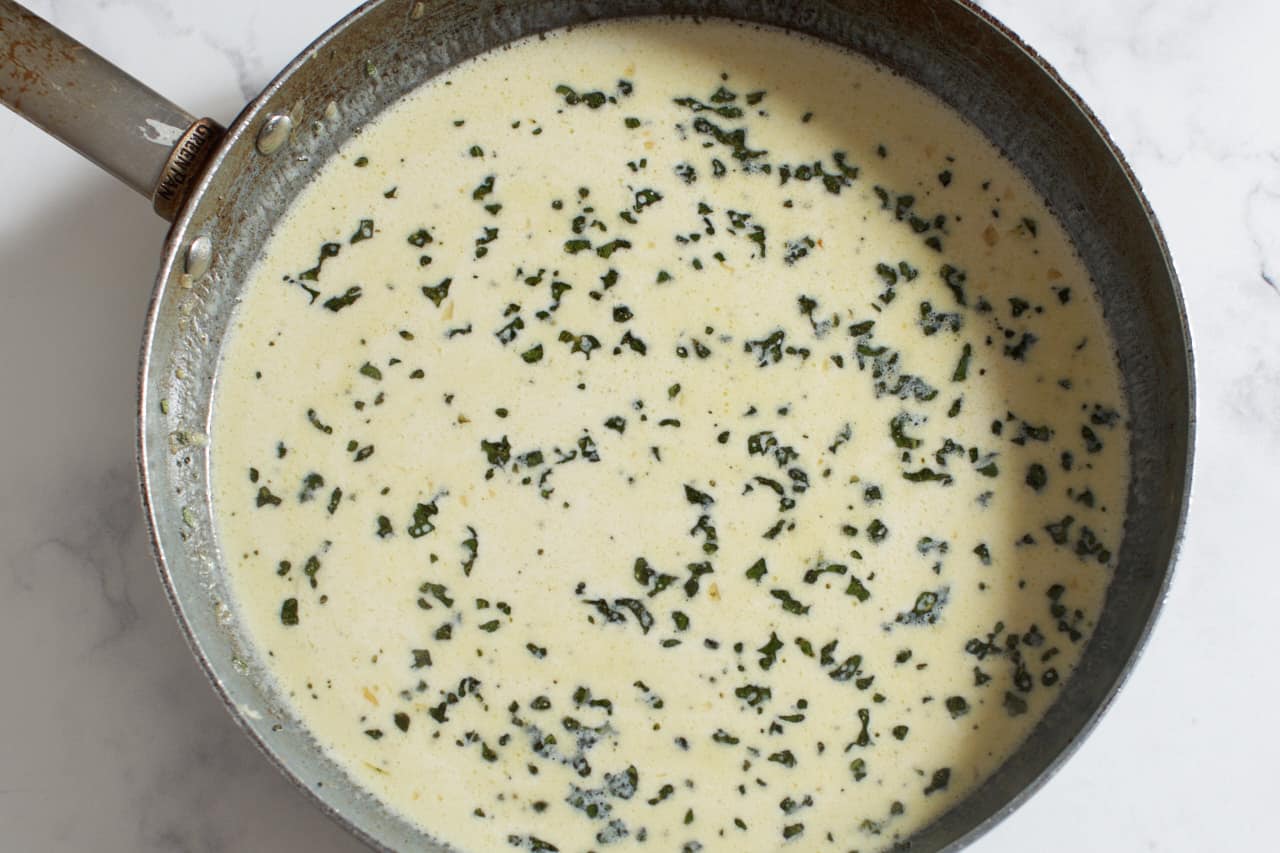
Step 4: Make the gratin sauce
Turn the heat down to medium low, and add the heavy cream and 3 ounces of the parmesan, stirring constantly, to melt the cheese and thicken the sauce.
You want it hot, but don't let it start simmering, you don't want to scald the cream.
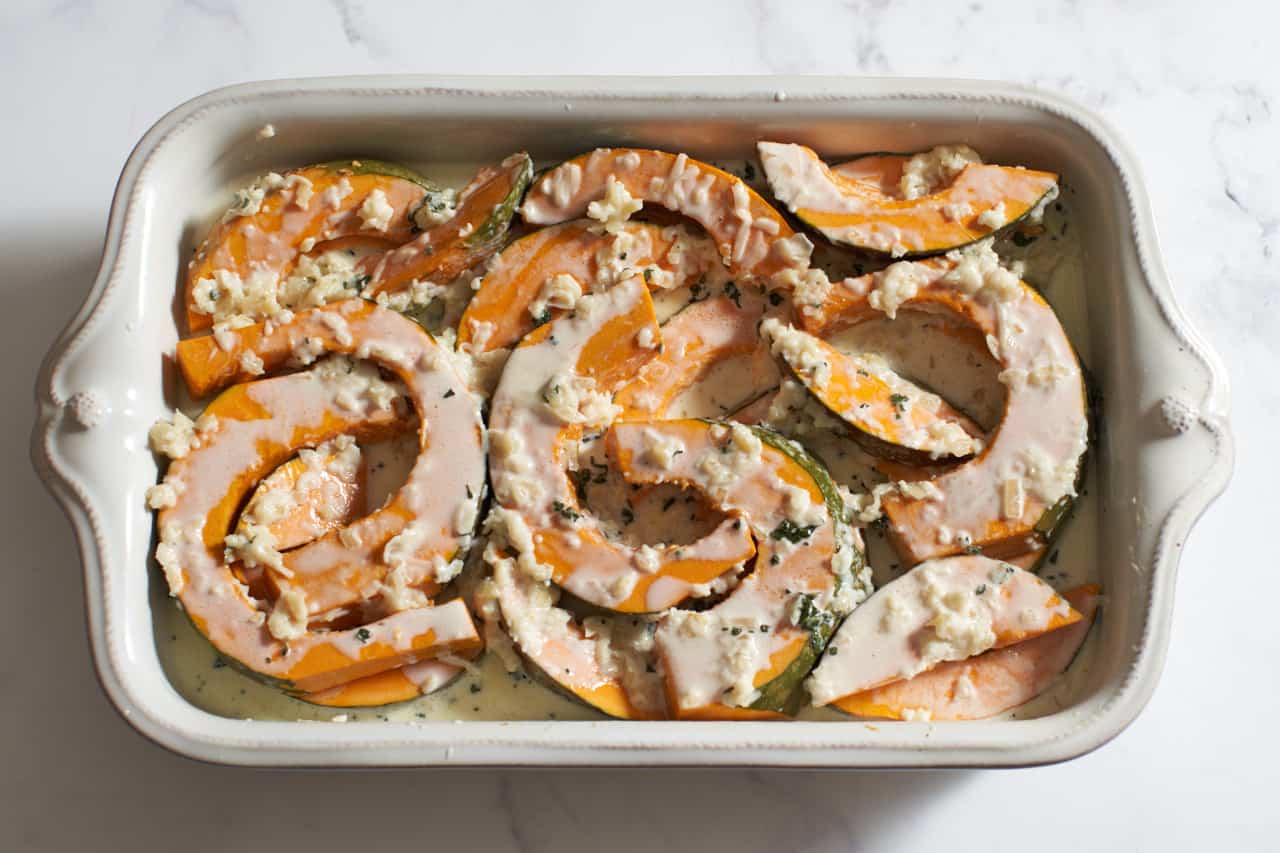
Step 5: Bake!
Spoon the sauce over the squash, evenly distributing the herb/shallot mixture throughout.
Cover tightly with foil and bake for about 30 minutes or until the sauce is bubbling and the squash is fork tender. Remove the foil and continue to cook for a few minutes, letting the sauce thicken.
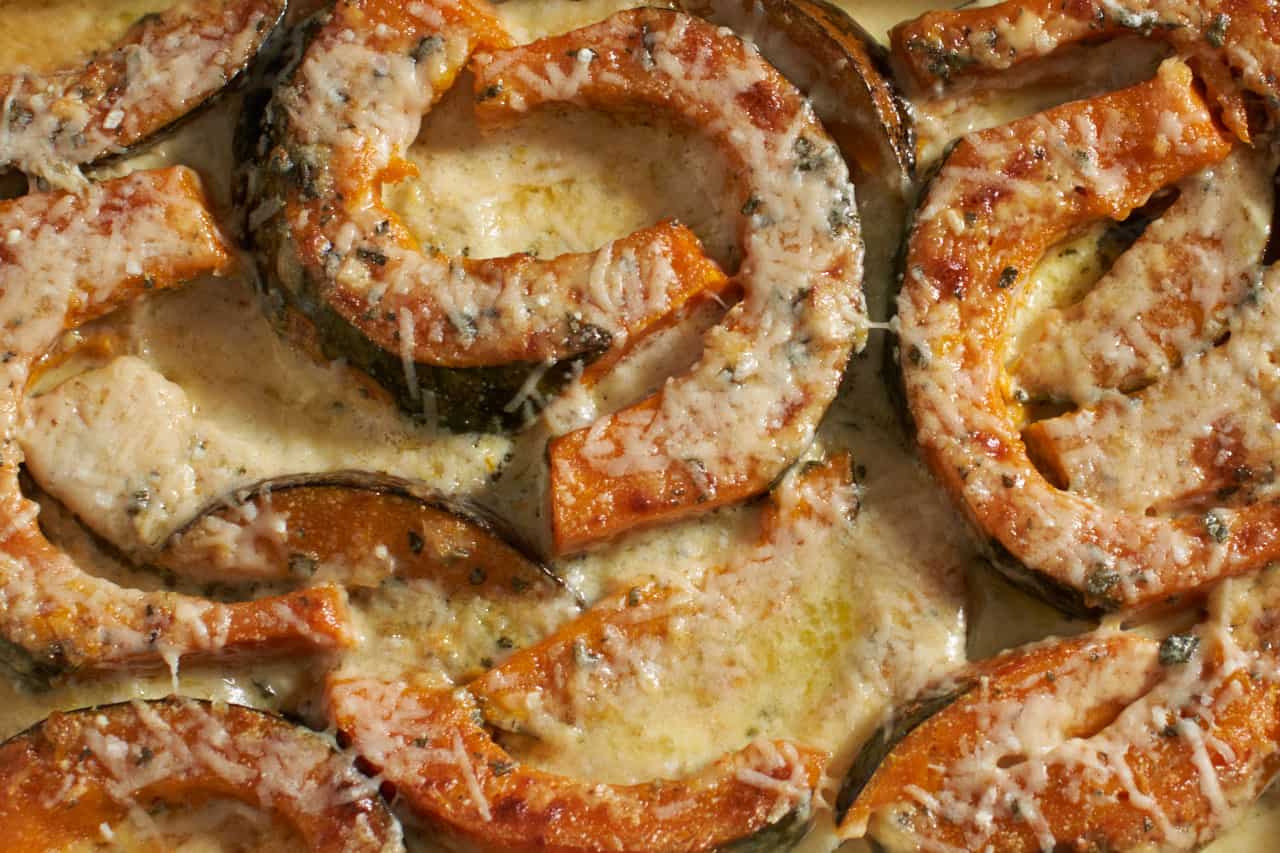
Step 6: Add more cheese!
Then top with the remaining parmesan cheese and cook until it is melted and beginning to brown on top.
Remove from the oven and let stand for at least five minutes before serving.
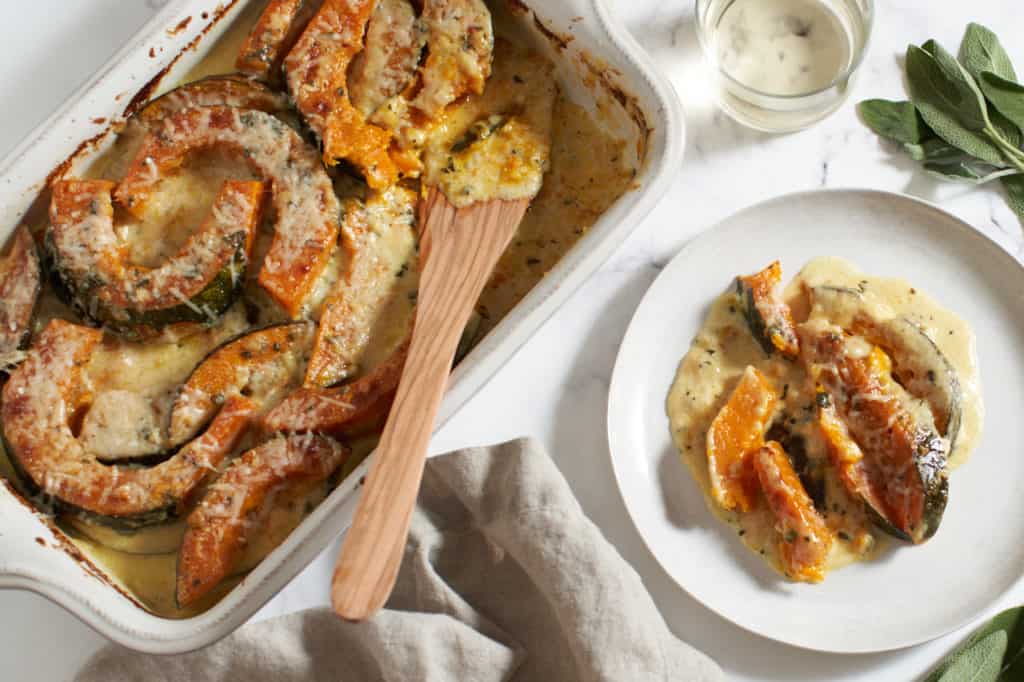
Expert tips
- Kabocha squash has a tendency to be a bit rough on the outside: If there are any especially rough or nubby spots, use a vegetable peeler or paring knife to shave them off.
- I always prefer to grate my own parmesan cheese: Pre-grated cheese has a tendency to dry out, or to be coated with anti-caking agents that prevent even melting. I grated this on the small holes of a box grater.
- Slicing winter squash can be difficult, but a few techniques make it easier: Use a good knife and be careful and take your time. Use a cutting board with rubber grips to keep it from slipping when you press down. If possible, slice off the very bottom so it sits on a flat surface and isn't wobbling all over. Kabocha squash has an especially thick stem, so you may have to slice around it for a while before you can remove it. Once you actually slice it open, things will get much easier.
- Cooking time may vary depending on the type of squash you're using: Kabocha will take a little longer than acorn and delicata.
- Protect your oven from sauce overflow: You may want to place the baking dish on a sheet pan to avoid any spillage from the creamy sauce.
FAQ
Yes you can! You can eat the skin of most winter squashes like delicata and acorn. Although it's a little bit thicker, you can also eat the skin of butternut squash if roasted at high heat. But in this gratin if you choose to use butternut squash you should peel it. The thicker skin and this sauce don't work together.
Kabocha tastes kind of like a cross between a pumpkin and a sweet potato with some chestnut and earthiness thrown in. If you like butternut squash, you will love kabocha squash!
Yes! Any winter squash will work, or try a mix of 2 or 3 different kinds.
Unfortunately, this does not freeze well. The cream sauce just won't get creamy again. Don't worry, you'll want to eat it all!
More winter squash recipes
- Maple Roasted Acorn Squash is a little savory, a little sweet, and only has 5 ingredients!
- If you're looking for more ways to use winter squash in comforting, cheesy dishes, try this Butternut Squash Lasagna. It uses a canned butternut squash purée to keep things really simple, or you can roast it yourself and purée in a food processor.
- On the lighter side, roast the squash with the skin on for this Roasted Butternut Squash and Avocado Salad.
If you enjoy this recipe, please leave me a 5-star rating ⭐️⭐️⭐️⭐️⭐️ in the recipe card! It really helps others find my content and helps my business grow! Sign up for my newsletter for recipes delivered to your inbox and follow me on Instagram and Pinterest! Thank you!
Recipe

Winter Squash Gratin (Kabocha, Delicata or Acorn)
Want to save this recipe?
You'll join hundreds of readers on my email list!
Ingredients
- 3 pounds winter squash such as kabocha, delicata, acorn or butternut
- 3 tablespoons butter (plus more for the pan)
- 1 shallot
- 3 cloves garlic
- ½ teaspoon kosher salt
- 2 tablespoons chopped sage
- 2 cups heavy cream
- 4 ounces parmesan cheese (divided)
Instructions
- Turn the heat down to medium low, and add the heavy cream and three-fourths of the parmesan (3 ounces), stirring constantly, to melt the cheese and thicken the sauce. You want it hot, but just shy of simmering.
- Spoon the sauce over the squash in the baking dish, evenly distributing the herb/shallot mixture throughout. Cover tightly with foil and bake for about 30 minutes or until the sauce is bubbling and the squash is fork tender. Then remove the foil and continue to cook for a few minutes, letting the sauce thicken a bit.
- Top with the remaining parmesan cheese and cook until it is melted and beginning to brown on top. Remove from the oven and let stand for at least five minutes before serving.
Notes
- There's no need to peel the squash: If using kabocha, acorn, or delicata squash, you can leave the peel intact. It's thin, edible, and pretty, and adds a little texture. But do peel butternut. The skin of butternut is also edible, and I often leave it on when I'm just roasting it. But it's thicker, so not as pleasant in this recipe.
- I always prefer to grate my own parmesan cheese: Pre-grated cheese has a tendency to dry out, or to be coated with anti-caking agents that prevent even melting. I grated this on the small holes of a box grater. For the cheese I added to the sauce, I broke it up with my fingers until it had a crumb-like texture to ensure even distribution. For the cheese topping, I left it in the nice long grated strips so it looks pretty on top when melted!
- Kabocha squash has a tendency to be a bit rough on the outside: If there are any especially rough or nubby spots, use a vegetable peeler or paring knife to shave them off.
- Slicing winter squash can be difficult, but a few techniques make it easier: Use a sharp knife and be careful and take your time. Use a cutting board with rubber grips to keep it from slipping when you press down. If possible, slice off the very bottom so it sits on a flat surface and isn't wobbling all over. Kabocha squash has an especially thick stem, so you may have to slice around it for a while before you can remove it. Once you actually slice it open, things will get much easier.
- Cooking time can vary depending on which squash you use: Kabocha will take longer than acorn or delicata.
Nutrition
Nutrition information is automatically calculated as an estimate. Calorie accuracy is not guaranteed.


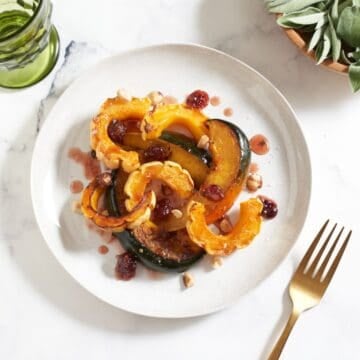
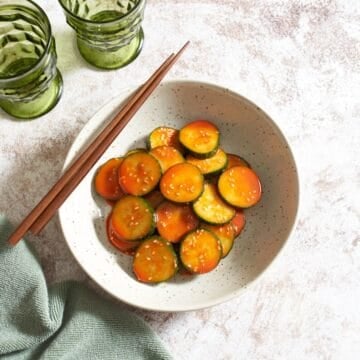
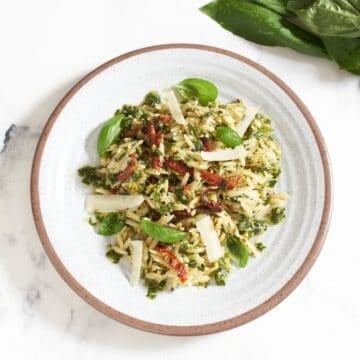

Leave a Reply